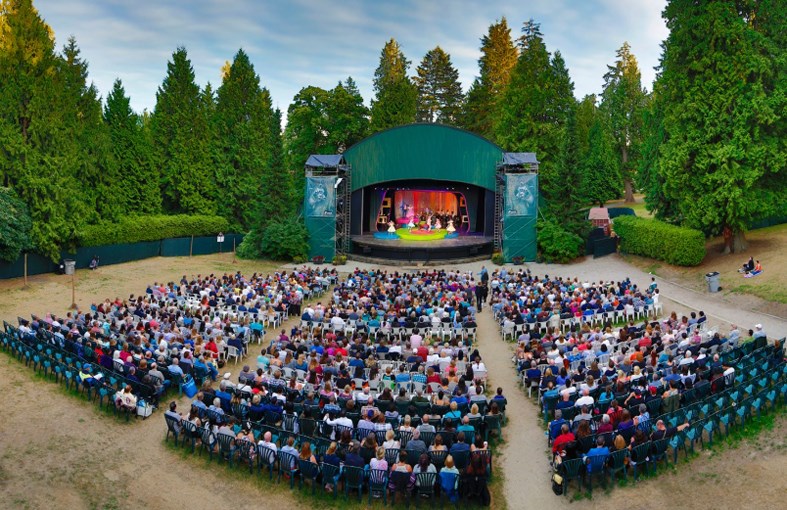In 1953 or ’54, one-time Theatre Under the Stars business manager Gordon Hilker moved with his wife, Betty, and children to a home in Cove Cliff on Strathcona Road.
His son Michael and daughter Judy grew up here and attended Burrard View School and later Windsor. In learning about Gordon Hilker’s accomplishments in the entertainment industry, first Vancouver and then throughout North America, it has to be wondered how he dealt with all the stress of trying to make something exceptional in spite of the constant roadblocks he seemed to face.
He was dealing with big money, much of it public money, in lean times. When asked, Judy laughed and said “he handled stress well. He loved to garden and would spend hours in the garden by himself. I think that was how he got relief.”
In reading about this remarkable man, it seemed (at least throughout the 1940s) he had to struggle with the Parks Board and others at every turn to succeed, but succeed he did. The comprehensive paper written in July 1993 by Richard Sutherland for his UBC thesis “Theatre Under the Stars: The Hilker Years,” provided great insights.
Musical theatre in Stanley Park began for the Golden Jubilee in 1936 when three months of entertainment including Shakespeare’s A Midsummer Night’s Dream was produced at Brockton Point. It was a hit with the public but a financial loss. In 1940, viable musicals in the park (under the new name Theatre Under the Stars) were attempted but all suffered losses.
The fortunes of TUTS changed when 28-year-old J.G. (Gordon) Hilker was employed as business manager in 1941. Already a successful impresario through his company, Hilker
Attractions, he was well known for bringing celebrated talent to Vancouver, most notably Martha Graham and her dancers. In 1938 he had produced a summer concert at Malkin Bowl in Stanley Park. As well as bringing established and popular talent to Vancouver, Hilker Attractions was also a talent agency that kept him connected in the local entertainment circle.
The summer musicals produced showed a small profit that very first year under his watch. The productions grew larger, and over the next few years TUTS became a fully professional company. In 1943, Hilker arranged to have the casts (more than 100 people) of the three productions at the time go to Seattle by train for a two-week run. The following year, the tour expanded to four weeks and covered Portland and Seattle; in 1945, Seattle, Portland and Tacoma over three weeks.
In 1944, Hilker created the British Columbia Institute of Music and Drama. It was associated with TUTS as a performers’ training ground to improve the talent of productions. Because all the costumes were designed and made in Winnipeg, Hilker created an, albeit cramped, costume studio in Vancouver that designed and made the costumes for the TUTS shows, but also rented them out. Later he created a similar independent house for set building.
The institute, costume and set studios were year-round operations, giving TUTS a greater profile. In 1946, he hired choreographer Aida Broadbent, who has been given credit for considerably raising the quality of the TUTS shows, and he hired Hugh Pickett as company manager. Pickett’s talent for publicity was renowned.
By 1949, even though Gordon Hilker was considered the man behind the financial success of TUTS, there had been an ongoing battle between the company, the Parks Board and the newly created Vancouver Civic Theatre Society involving finances and questions that arose regarding the legalities of the Parks Board running TUTS and the institute. As the situation became intense Hilker withdrew his name for renewal of his position, becoming a casualty of the struggle but only to go on to greater things.
After TUTS he went to work at his father’s dry goods store before leaving for the east. During the 1950s, he worked organizing centennial festivals and joined the Vancouver International Festival before becoming artistic director of the World Festival at Expo ’67 in Montreal. The project began in 1964 and the next three years he visited 36 countries, booked 155 attractions and 25,000 entertainers with a diverse group of entertainers including log rollers and ballerinas. It was another great triumph for Gordon Hilker and his team.
After Expo ’67, he left Canada to teach at the School of Performing Arts in San Diego from 1968 to 1972 and organized parks events through many states. He wrote a book called “The Audience and You; Practical Dramatics for the Park Interpreter.” He was hired to do the artistic planning of Expo ’74 in Spokane, Wash., Expo ’82 in Knoxville, Tenn., and Expo ’86 in Vancouver. The U.S. Department of Interior and National Parks enlisted his talents for its 1975-1976 bicentennial project called The People of 1776.
After retiring he lived in his home on Indian Arm. Gordon Hilker died on April 4, 1991.
Eileen Smith is a director with the Deep Cove Heritage Society. deepcoveheritage.com



